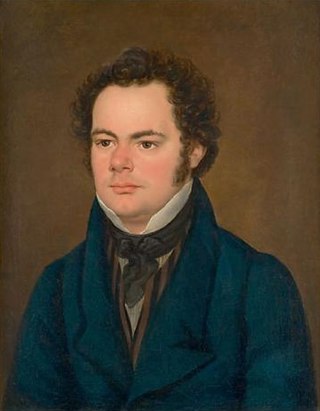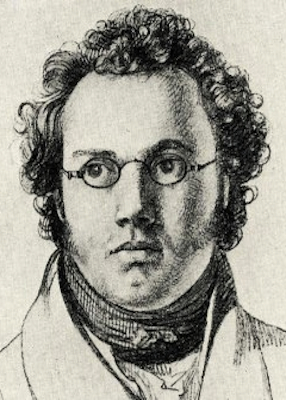
Franz Peter Schubert was an Austrian composer of the late Classical and early Romantic eras. Despite his short life, Schubert left behind a vast oeuvre, including more than 600 secular vocal works, seven complete symphonies, sacred music, operas, incidental music, and a large body of piano and chamber music. His major works include the art songs "Erlkönig", "Gretchen am Spinnrade", and "Ave Maria"; the Trout Quintet; the Symphony No. 8 in B minor (Unfinished); the Symphony No. 9 in C major (Great); the String Quartet No. 14 in D minor ; the String Quintet in C major; the Impromptus for solo piano; the last three piano sonatas; the Fantasia in F minor for piano four hands; the opera Fierrabras; the incidental music to the play Rosamunde; and the song cycles Die schöne Müllerin, Winterreise and Schwanengesang.
Sonata form is a musical structure generally consisting of three main sections: an exposition, a development, and a recapitulation. It has been used widely since the middle of the 18th century.
The Takács Quartet is a string quartet founded in Budapest, Hungary, and now based in Boulder, Colorado, United States.
This article is about music-related events in 1824.

The Trout Quintet (Forellenquintett) is the popular name for the Piano Quintet in A major, D. 667, by Franz Schubert. The piano quintet was composed in 1819, when he was 22 years old; it was not published, however, until 1829, a year after his death.

The String Quartet No. 14 in C♯ minor, Op. 131, was completed by Ludwig van Beethoven in 1826. It is the last-composed of a trio of string quartets, written in the order Opp. 132, 130, 131.
Cyclic form is a technique of musical construction, involving multiple sections or movements, in which a theme, melody, or thematic material occurs in more than one movement as a unifying device. Sometimes a theme may occur at the beginning and end ; other times a theme occurs in a different guise in every part.

The String Quartet No. 14 in D minor, D 810, known as Death and the Maiden, is a piece by Franz Schubert that has been called "one of the pillars of the chamber music repertoire". It was composed in 1824, after the composer suffered from a serious illness and realized that he was dying. It is named for the theme of the second movement, which Schubert took from a song he wrote in 1817 of the same title. But, writes Walter Willson Cobbett, all four movements of the quartet are welded "into a unity under the pressure of a dominating idea - the dance of death."
A minor is a minor scale based on A, A, B, C, D, E, F, and G. Its key signature has no flats and no sharps. Its relative major is C major and its parallel major is A major.

Franz Schubert's final chamber work, the String Quintet in C major is sometimes called the "Cello Quintet" because it is scored for a standard string quartet plus an extra cello instead of the extra viola which is more usual in conventional string quintets. It was composed in 1828 and completed just two months before the composer's death. The first public performance of the piece did not occur until 1850, and publication occurred three years later in 1853. Schubert's only full-fledged string quintet, it has been praised as "sublime" or "extraordinary" and as possessing "bottomless pathos," and is generally regarded as Schubert's finest chamber work as well as one of the greatest compositions in all chamber music.

The Quartettsatz c-Moll D 703 was composed by Franz Schubert in December 1820 as the first movement, Allegro assai, of a string quartet he was never to complete. Upon publication it was nonetheless listed as his "String Quartet No. 12". The nine-minute work is regarded as an early product of the composer's mature phase of output.

Ignaz Schuppanzigh was an Austrian violinist and friend of Beethoven, and leader of Count Razumovsky's private string quartet. Schuppanzigh and his quartet premiered many of Beethoven's string quartets, and in particular, the late string quartets. The Razumovsky quartet, which Schuppanzigh founded in late 1808, is considered to be the first professional string quartet. Until the founding of this quartet, quartet music was played primarily by amateurs or by professional musicians who joined together on an ad hoc basis.

Franz Schubert wrote his Sonata in C major for piano four-hands, D 812, in June 1824 during his second stay at the Esterházy estate in Želiezovce. The extended work, in four movements, has a performance time of around 40 to 45 minutes. It was published as Grand Duo, Op. 140, in 1837, nine years after the composer's death.
The String Quintet No. 3 in C major, K. 515 was written by Wolfgang Amadeus Mozart. Like all of Mozart's string quintets, it is a "viola quintet" in that it is scored for string quartet and an extra viola.
The Symphony No. 4 in C minor, D 417, is a symphony by Franz Schubert completed in April 1816 when Schubert was 19 years old, a year after his Third Symphony However, it was not premiered until November 19, 1849, in Leipzig, more than two decades after Schubert's death. The symphony was called the Tragic by its composer.
Brian Newbould is an English composer, conductor and author who has conjecturally completed Franz Schubert's Symphonies D 708A in D major, No. 7 in E major, No. 8 in B minor ("Unfinished"), No. 10 ("Last") in D major, Piano Sonata in C major, D 840, Quartettsatz, D. 703 and String Trio, D. 471. He was educated at Gravesend Grammar School, and earned a BMus degree with top honors from the University of Bristol.
The Schuppanzigh Quartet was a string quartet formed in Vienna in the 1790s by the violinist Ignaz Schuppanzigh. It continued, with breaks and changes of membership, for many years. Schuppanzigh was a close friend and admirer of Ludwig van Beethoven, and the quartet gave the first performances of many of Beethoven's string quartets.

Joseph Linke was a cellist and composer who had a distinguished career in Vienna, as a soloist and as a member of the Schuppanzigh Quartet. He took part in the first performances of string quartets and other chamber works of Ludwig van Beethoven and Franz Schubert.
In music, Op. 2 stands for Opus number 2. Compositions that are assigned this number include:








